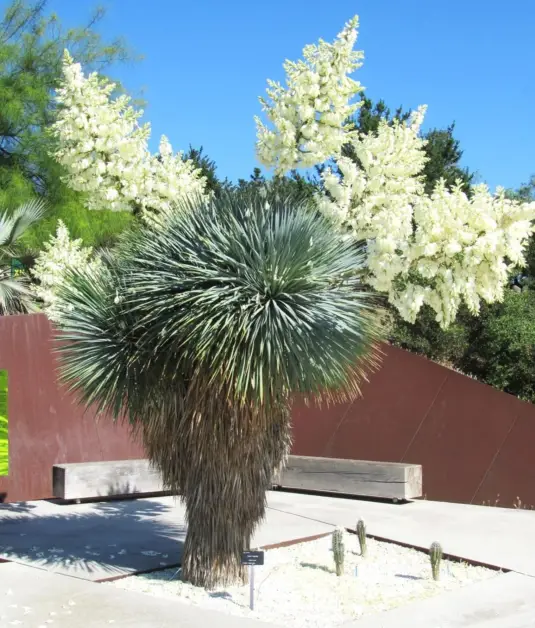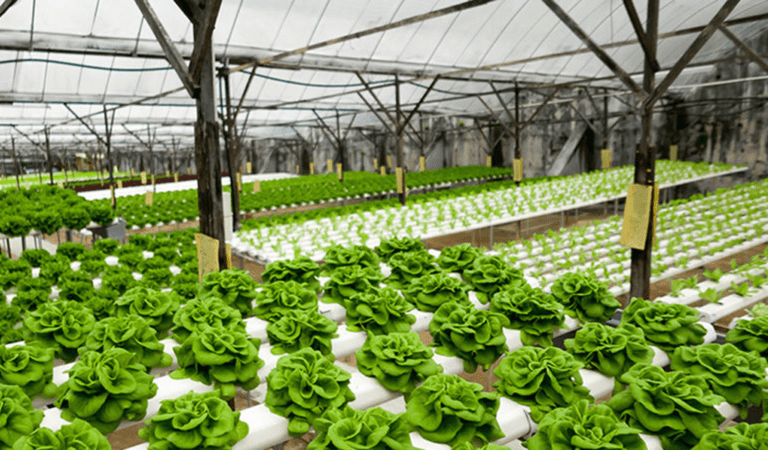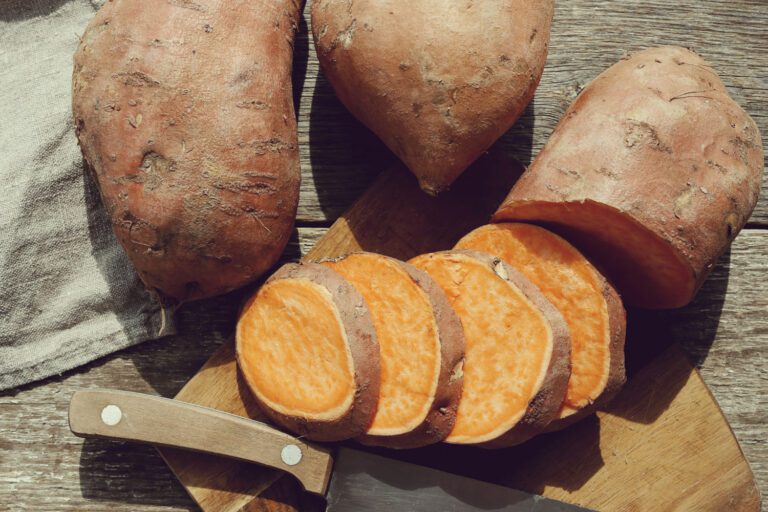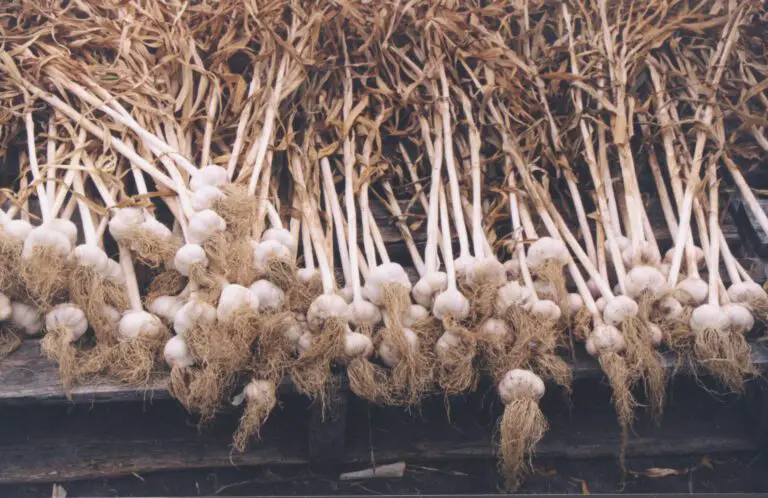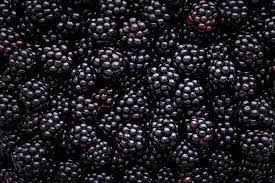Yucca Rostrata Super Care: No. 1 Growing the Blue Beaked Yucca
Craving a splash of desert charm in your landscape? Look no further than the Yucca Rostrata, also known as the Blue Beaked Yucca! This low-maintenance, drought-tolerant stunner boasts striking blue foliage and a majestic presence, making it a popular choice for gardens across the US. But what’s the secret to cultivating this architectural marvel? Buckle up, plant enthusiasts, because we’re diving deep into the world of Yucca Rostrata super care, from soil secrets to watering wisdom. Get ready to transform your garden into a desert oasis with this comprehensive guide!
Table of Contents
Yucca Rostrata Care: Growing the Blue Beaked Yucca
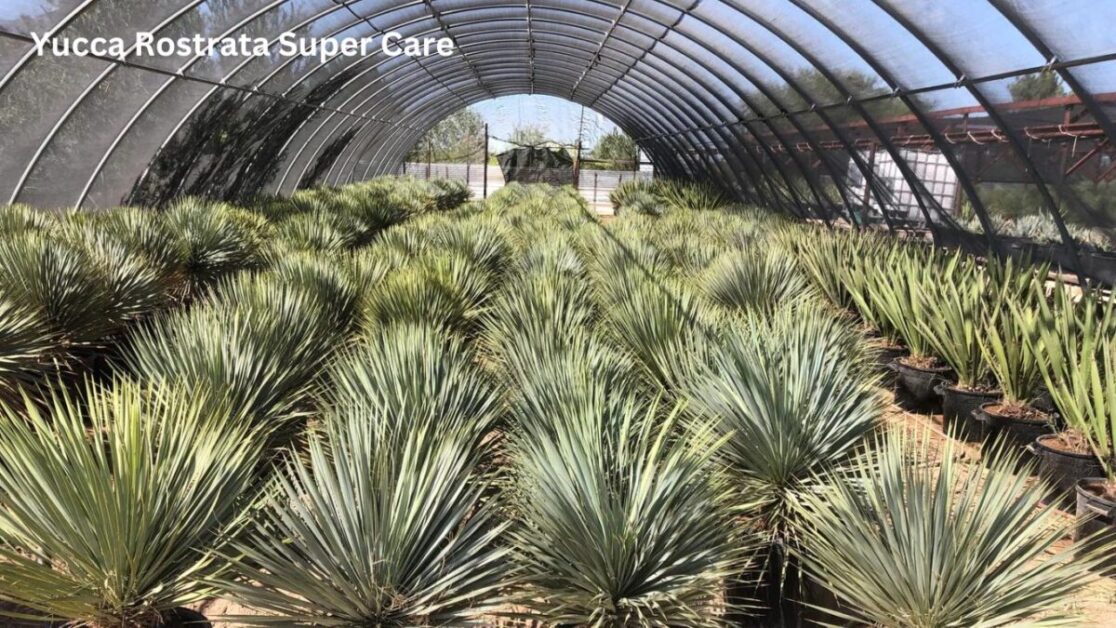
The Blue Beaked Yucca, scientifically known as Yucca Rostrata, is an eye-catching plant that can add a touch of elegance to any garden or landscape. Native to the high deserts of northern Mexico, this yucca species is highly valued for its distinctive blue-gray color and architectural form. Its long, slender leaves grow in a rosette shape and curve gracefully inward, creating a striking silhouette against the backdrop of the sky.
Growing the Blue Beaked Yucca requires an understanding of its ideal growing conditions. This yucca species thrives in full sun and well-draining soil, making it a perfect choice for arid and desert gardens. It is highly drought-tolerant and can withstand hot, dry summers with minimal water requirements. However, it is important to ensure proper soil preparation and watering techniques to help the plant establish and thrive in its new environment. In the next sections, we will delve into the necessary steps to successfully cultivate and care for Yucca Rostrata.
1. Overview of the Blue Beaked Yucca
The Blue Beaked Yucca, also known as Yucca Rostrata, is a stunning and unique plant that can be a focal point in any garden or landscape. This yucca species is native to the Chihuahuan Desert in northern Mexico and western Texas, and it is highly regarded for its striking blue-gray foliage and tall, narrow shape.
Yucca Rostrata can reach heights of up to 15 feet, with a trunk that often branches out near the top. The leaves form a rosette at the summit, with narrow, sword-shaped leaves that can grow up to 2 feet long. The characteristic blue-gray color of the foliage gives the plant its distinctive appearance, making it a popular choice for xeriscaping and contemporary garden designs.
In addition to its striking appearance, the Blue Beaked Yucca is known for its hardiness and ability to tolerate a wide range of growing conditions. It is highly adaptable and can thrive in both full sun and partial shade, making it suitable for various climates and environments. Its tolerance to drought and low water requirements also make it an excellent choice for water-wise gardening. Overall, the Blue Beaked Yucca is an attractive and resilient plant that can add a touch of elegance to any garden or landscape.
2. Understanding the Ideal Growing Conditions for Yucca
Yucca rostrata, commonly known as the Blue Beaked Yucca, thrives in specific growing conditions that mimic its natural habitat. Understanding these ideal conditions is crucial for successful cultivation. This striking plant is native to the Chihuahuan Desert in northern Mexico and parts of western Texas and New Mexico, where it adapts to the arid, desert-like environment.
The table list the ideal growing conditions for Yucca!
| Factor | Ideal Condition | Notes |
|---|---|---|
| Light | Full sun (at least 6 hours daily) | Yucca thrives in bright, direct sunlight |
| Temperature | Warm to hot | Prefers temperatures between 70°F and 90°F (21°C and 32°C) |
| Soil | Well-draining, sandy or gravelly soil | Avoid heavy clay soils that retain too much water |
| Watering | Infrequent, only when the soil is completely dry | Overwatering is the leading cause of Yucca problems |
| Fertilization | Minimal to none | Too much fertilizer can encourage unwanted growth and weaken the plant |
| Pests & Diseases | Generally pest and disease resistant | Monitor for signs of scale and mealybugs, and treat accordingly |
When it comes to temperature, the Blue Beaked Yucca prefers hot and dry climates. It is highly tolerant of heat and can withstand temperatures exceeding 100°F (37°C) during summer months. However, it’s essential to note that this yucca variety also requires a significant drop in temperature during the winter to trigger its dormancy period. Ideally, temperatures around 20°F (-6°C) provide the necessary cold stimulus, ensuring healthy growth and flowering cycles. These temperature requirements are crucial to consider when choosing to grow the Blue Beaked Yucca in regions with milder or colder climates.
Here are some points, you can keep in mind!
- Yucca can tolerate some shade, but full sun is crucial for optimal growth and flowering.
- Younger plants may benefit from occasional watering during their first year of establishment.
- If your soil is not well-draining, consider adding sand or gravel to improve drainage.
- Yucca are slow-growing plants, so be patient! They typically only need repotting every few years.
3. Choosing the Right Location for Your Blue Beaked Yucca
When it comes to choosing the right location for your Blue Beaked Yucca, there are a few key factors to consider. First and foremost, this plant thrives in full sun, so it’s important to find an area in your garden or landscape that receives at least 6 to 8 hours of direct sunlight each day. This will ensure that your Yucca Rostrata gets the energy it needs to grow and flourish.
In addition to sunlight, soil drainage is also crucial for the success of your Blue Beaked Yucca. These plants prefer well-draining soil that doesn’t hold excess moisture. If your soil tends to be heavy or clay-like, consider amending it with organic matter, such as compost or sand, to improve drainage. This will help prevent the roots from becoming waterlogged, which can lead to root rot and other issues. By selecting a location with proper sunlight and well-drained soil, you’ll be setting the stage for a healthy and thriving Blue Beaked Yucca in your garden.
4. Selecting the Appropriate Soil for Yucca
When selecting soil for Yucca Rostrata, it is crucial to consider its natural habitat and the conditions it thrives in. This blue beaked yucca is native to the arid regions of the Chihuahuan Desert, where the soil is well-draining and sandy. Therefore, replicating these conditions is vital for the optimal growth and health of your yucca plant.
To ensure proper soil selection, it is recommended to use a well-draining mix. Sandy or loamy soil with good drainage will prevent excess moisture retention, which can lead to root rot and other detrimental issues. Moreover, amending the soil with organic matter, such as compost or well-rotted manure, can enhance its fertility and water-holding capacity without compromising drainage.
| Feature | Ideal | Non-Ideal |
|---|---|---|
| Drainage | Well-draining | Poorly draining |
| Texture | Sandy or gravelly | Heavy clay |
| Moisture retention | Low | High |
| Amendments | Sand, gravel, or perlite | None needed (if soil already well-draining) |
| Why It Matters | Prevents root rot, allows roots to breathe | Can suffocate roots, lead to root rot |
It’s worth noting that Yucca Rostrata is adaptable and can tolerate a range of soil pH levels, including slightly acidic to slightly alkaline. However, like most plants, it prefers a neutral pH around 6.0 to 7.0. Regularly testing the soil’s pH and adjusting it accordingly can help ensure the best conditions for your yucca’s growth.
Some Additional points for selecting the right soil for your Yuccas!
- When mixing your own soil mix, a common recommendation is a 3:1 ratio of sand or gravel to peat moss.
- If unsure about your soil’s drainage, perform a simple test: dig a hole about a foot deep and fill it with water. If the water drains completely within a few hours, your drainage is good. If it takes much longer or remains standing, amending the soil is recommended.
- Remember, Yuccas are low-maintenance plants. When in doubt, opt for a soil mix that leans drier rather than water-retentive.
5. How to Plant Yucca in Your Garden or Landscape
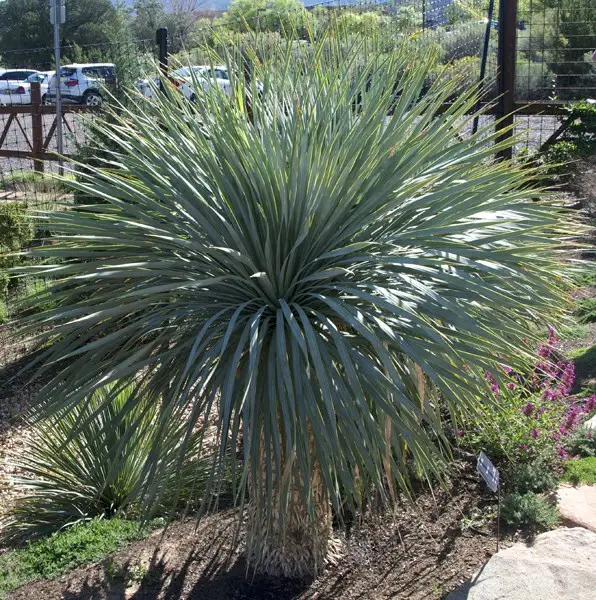
Yucca plants are a popular addition to gardens and landscapes due to their unique, architectural look and low maintenance requirements. To plant yucca in your garden or landscape, start by selecting a location that receives plenty of sunlight and has well-drained soil. Once you have chosen the perfect spot for your yucca plant, it’s time to prepare the soil. Yucca plants thrive in well-drained soil, so it’s essential to ensure that the soil is not waterlogged. If your soil is heavy or clay-like, consider amending it with sand or perlite to improve drainage.
When it comes to planting the yucca, dig a hole that is about twice the width of the plant’s root ball and of equal depth. Carefully remove the plant from its container and gently loosen the roots before placing it in the hole. Backfill the hole with soil and firmly press it down to remove any air pockets.
Water the newly planted yucca thoroughly and continue to water it regularly, especially during the plant’s first growing season. Once established, yucca plants are quite drought tolerant and only require occasional watering. In addition, applying a layer of mulch around the base of the plant can help conserve moisture and suppress weed growth.
6. Watering Techniques for Blue Beaked Yucca
Watering techniques hold utmost importance in caring for Blue Beaked Yucca (Yucca Rostrata), which originate from arid environments and demand well-drained soil to flourish. Due to their adaptation to low water availability, improper hydration practices could compromise the plant’s health and lifespan.
To nurture your Blue Beaked Yucca optimally, strive to find a balance between supplying sufficient moisture for growth without causing oversaturation. This plant prefers drier climatic conditions and might deteriorate if subjected to excessively wet soil. Adopt a strategy where you water deeply but infrequently; allow the soil to fully dry out between waterings, and then apply thorough irrigation, making sure the water reaches the root zone.
This technique fosters robust root systems and enhances the plant’s resilience towards drought. Additionally, remember that mature Blue Beaked Yucca demands lesser water than young specimens. Continuous monitoring of soil moisture levels and adapting your watering routine accordingly will guarantee ideal circumstances for your Blue Beaked Yucca.
7. Pruning and Trimming Tips for Yucca
Pruning and trimming are essential aspects of maintaining the health and appearance of your Yucca Rostrata plant. Regular pruning helps to remove dead or damaged foliage, promote new growth, and keep the plant’s overall shape neat and tidy.
When it comes to pruning Yucca Rostrata, it’s important to follow some guidelines to ensure you achieve the best results. Firstly, always use clean and sharp pruning shears to make clean cuts without damaging the plant. Start by removing any dead or yellowed leaves at the base of the plant, cutting them as close to the stem as possible. This helps to prevent the buildup of debris and pests.
During the pruning process, it’s essential to prioritize the health and shape of the Yucca. Remove any crossed or overlapping branches to improve air circulation within the plant and reduce the risk of disease. Additionally, you can trim any lower branches if you prefer a more tree-like appearance. Remember to always prune selectively and avoid overly aggressive trimming, as it may harm the plant’s health.
8. Fertilizing the Blue Beaked Yucca: Dos and Don’ts
Dos:
1. Use a balanced slow-release fertilizer: When it comes to fertilizing the Blue Beaked Yucca, it is best to opt for a balanced slow-release fertilizer. This type of fertilizer provides a steady supply of nutrients to the plant over an extended period, ensuring optimal growth and health. Look for a fertilizer with an N-P-K ratio of 10-10-10 or similar, as this will provide a good balance of nitrogen, phosphorus, and potassium, which are essential for overall plant development.
2. Apply fertilizer sparingly: Yucca Rostrata is a resilient plant that thrives in poor soil conditions. Therefore, it is crucial not to over-fertilize and risk causing nutrient imbalances or burning the roots. Apply the fertilizer sparingly, following the package instructions or using half the recommended dosage.
Don’ts:
1. Avoid high-nitrogen fertilizers: Yucca Rostrata does not require excessive amounts of nitrogen, as it can lead to fast, weak growth and make the plant more susceptible to diseases and pest infestations. Avoid using high-nitrogen fertilizers, particularly those designed for lawns or leafy vegetables, as they typically contain nitrogen in more significant quantities.
2. Do not fertilize during the dormant period: Blue Beaked Yucca enters a period of dormancy during the colder months. During this time, the plant’s growth slows down significantly, and it does not require as many nutrients. Avoid fertilizing the yucca during its dormant period to avoid stimulating new growth, which may be more vulnerable to cold damage.
| Dos | Don’ts |
|---|---|
| Use a well-draining, acidic soil mix rich in organic matter to ensure proper drainage and aeration, preventing waterlogged conditions that can lead to root rot. | Avoid overwatering, as Blue Beaked Yuccas are drought-tolerant plants; water sparingly and allow the soil to dry out between waterings to prevent root rot. |
| Position the plant in a location that receives full sun for at least 6 hours a day to promote healthy growth, vibrant foliage, and prolific flowering. | Do not expose the plant to direct harsh sunlight during the hottest part of the day, as it can scorch the leaves and cause sunburn. Provide some shade during peak sunlight hours. |
| Water the plant regularly during the active growing season (spring and summer), ensuring the soil is evenly moist but not waterlogged, to support growth and blooming. | Avoid using hard water or tap water high in salts and chemicals, which can cause mineral buildup in the soil and harm the plant; opt for purified or distilled water instead. |
| Fertilize sparingly with a balanced liquid fertilizer diluted to half strength every 4-6 weeks in spring and summer to provide essential nutrients without overwhelming the plant. | Do not over-fertilize, as excessive nutrients can lead to fertilizer burn, salt buildup in the soil, and nutrient imbalances that may damage the roots and overall health of the plant. |
By following these fertilizing dos and don’ts, you can ensure that your Blue Beaked Yucca receives the right nutrients in the appropriate amounts, promoting healthy growth and overall vigor. Remember to always read and follow the instructions on fertilizer packaging and consult with a local gardening expert if you have any specific concerns regarding fertilization practices for your yucca.
9. Protecting Your Yucca Rostrata from Pests and Diseases
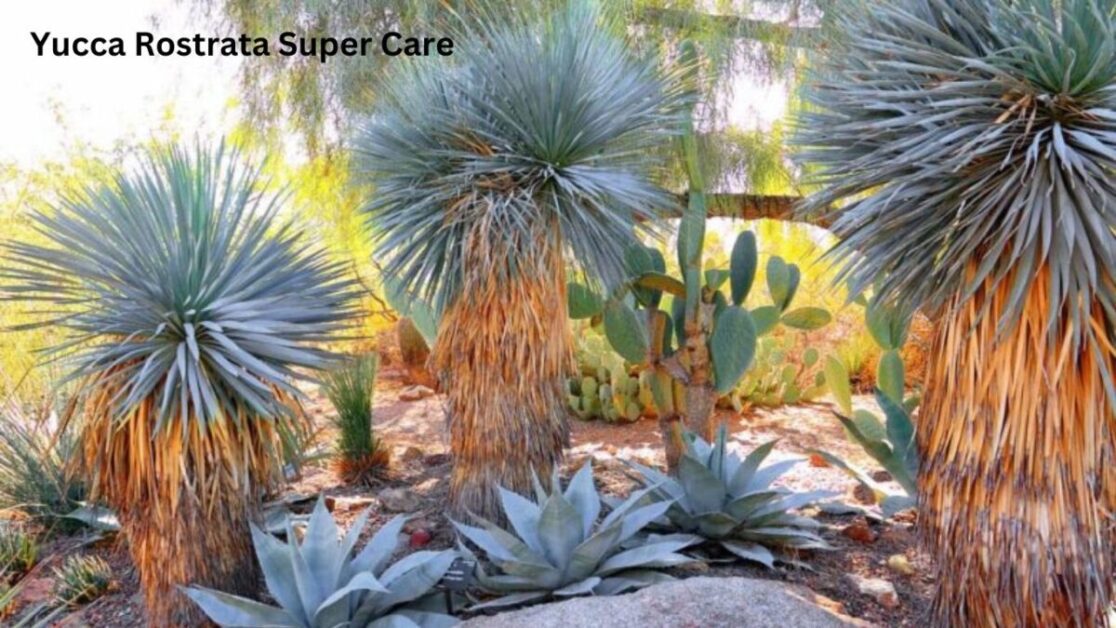
Protecting your Yucca Rostrata from pests and diseases is crucial in ensuring the health and vitality of these beautiful plants. While Yucca Rostrata is generally resistant to most pests and diseases, there are a few common culprits that you should be aware of.
One of the main pests that can infest Yucca Rostrata is the yucca weevil (Scyphophorus acupunctatus). These small beetles lay their eggs in the plant’s crown, causing damage to the growing tip and eventually leading to the death of the plant. To prevent infestations, it is important to regularly inspect your Yucca Rostrata for any signs of weevils or their larva. If you notice any infestation, remove the affected parts immediately and consider using a botanical insecticide specifically designed for weevil control. Additionally, practicing good sanitation by removing fallen leaves and debris around the base of the plant can help eliminate potential breeding grounds for these pests.
In terms of diseases, the most common issue that Yucca Rostrata can encounter is root rot caused by over-watering or poorly drained soil. To prevent this, it is essential to ensure that the soil is well-draining and that excess water can easily escape. Avoid waterlogged conditions by watering your Yucca Rostrata sparingly and allowing the soil to dry out between waterings. Additionally, be cautious of over-fertilization, as excessive nutrients can also contribute to root rot.
Providing a balanced fertilizer specifically formulated for succulent plants and following the recommended dosage will help maintain the health of your Yucca Rostrata. By being proactive in identifying and addressing these common pests and diseases, you can protect your Yucca Rostrata and enjoy its stunning beauty for years to come.
10. Common Mistakes to Avoid in Yucca Rostrata Care
When it comes to caring for Yucca Rostrata, there are several common mistakes that gardening enthusiasts should avoid. One of the most common errors is overwatering. While it’s important to provide the plant with sufficient moisture, Yucca Rostrata is highly drought-tolerant and actually thrives in well-draining soil. Overwatering can lead to root rot and other issues, so it’s crucial to avoid excessive watering and let the soil dry out between waterings.
Another mistake often made in Yucca Rostrata care is neglecting to provide proper sunlight. These plants require full sun exposure to reach their full potential and achieve that striking blue hue that they are known for. Without adequate sunlight, Yucca Rostrata may become leggy and stretched out, rather than maintaining a compact and sturdy form. Therefore, it’s essential to choose a location for your plant that receives at least six to eight hours of direct sunlight each day.
The table here describes the common mistakes, their description and prevention to avoid in Yucca Rostrata Care!
| Mistake | Description | Prevention |
|---|---|---|
| Overwatering | Providing excessive moisture can lead to root rot, yellow leaves, and a spongy trunk. | Allow the soil to dry out between waterings, ensure proper drainage, and water only when the soil is dry. |
| Insufficient Sunlight | Inadequate sunlight can result in leggy growth and failure to bloom. | Place the plant in a sunny location with at least 6-8 hours of direct sunlight per day to promote healthy growth. |
| Poor Drainage | Lack of proper drainage can cause waterlogged soil, leading to root rot and other issues. | Use well-draining soil and containers with drainage holes to prevent water accumulation around the roots. |
| Overfertilizing | Excessive fertilization can burn the roots and disrupt the plant’s growth cycle. | Use a balanced fertilizer sparingly during the growing season according to package instructions, and avoid overfeeding the plant. |
| Incorrect Pruning Timing | Pruning at the wrong time can stress the plant or remove potential flower buds. | Prune dead or damaged leaves in early spring before new growth begins to avoid harming the plant’s health. |
| Ignoring Pests and Diseases | Neglecting pest infestations or diseases can weaken the plant and impact its overall health. | Regularly inspect the plant for pests, treat infestations promptly, and address any diseases early to prevent further damage. |
| Inadequate Winter Protection | Failing to protect the plant from frost during winter can lead to cold damage and reduced vitality. | Cover the plant with frost cloth or burlap on cold nights, mulch around the base for insulation, and consider moving potted yuccas indoors in extreme cold conditions. |
11. Propagating Yucca Rostrata: Methods and Tips
Propagating Yucca Rostrata can be a rewarding experience for gardening enthusiasts looking to expand their collection of these striking plants. While propagating Yucca Rostrata can be challenging at times, with the right methods and tips, you can successfully grow new plants from existing ones.

One common method for propagating Yucca Rostrata is through stem cuttings. To do this, select a mature, healthy stem from the parent plant and make a clean cut, ensuring it is at least four inches long. Remove the lower leaves and allow the cutting to dry for a couple of days to prevent rot. Once the cutting has calloused, dip the cut end into rooting hormone powder and plant it in a well-draining soil mix. Keep the soil slightly moist and provide the cutting with bright, indirect light. With time and proper care, the cutting should develop roots and begin to grow into a new Yucca Rostrata plant.
Another method for propagating Yucca Rostrata is by division. This is best done when the plant has naturally formed multiple rosettes, or when the plant has grown too large and needs to be divided to maintain its health and shape. Carefully lift the plant from the ground, keeping the roots intact, and gently separate the individual rosettes. Ensure each division has a healthy root system attached. Replant the divisions in suitable soil, keeping them at the same depth as they were originally planted. Water the divisions thoroughly and provide them with proper sunlight and care. In a few weeks, the divisions should establish themselves and start growing, becoming independent Yucca Rostrata plants.
By employing these effective propagation methods, you can expand your Yucca Rostrata collection and enjoy the beauty of these unique plants in various corners of your garden or landscape.
12. Transplanting Yucca Rostrata: Step-by-Step Guide
Transplanting Yucca Rostrata is a rewarding process that can rejuvenate the plant and enhance its growth. By following a detailed and careful approach, you can ensure a successful transition for your yucca. Here is a more explanatory guide to help you through the process:
- Yucca Rostrata, also known as Beaked Yucca, is a striking plant with long, blue-green leaves that add a touch of elegance to any landscape. Transplanting this unique species requires attention to detail and proper care to ensure its health and vitality in its new environment.
- Before transplanting, assess the current location of your yucca and choose a new site that offers similar growing conditions, including ample sunlight and well-draining soil. Adequate preparation is key to minimizing stress on the plant during the transplant process.
- Begin by watering the yucca a few days before transplanting to ensure it is well-hydrated. Carefully dig around the plant, preserving as much of the root system as possible. Gently lift the yucca from the ground and transfer it to the prepared hole in its new location.
- After transplanting, water the yucca thoroughly to help it establish in its new surroundings. Monitor the plant for signs of stress and adjust watering as needed. Mulching around the base of the plant can help retain moisture and protect the roots.
By following these explanatory steps and providing attentive care, you can successfully transplant your Yucca Rostrata and enjoy its beauty in a new location for years to come.
13. Winter Care for Blue Beaked Yucca
During the winter months, it is important to provide proper care for your Blue Beaked Yucca to ensure its health and survival. As a hardy desert plant, the Yucca Rostrata is well adapted to withstand cold temperatures, but a little extra attention can go a long way in maintaining its vigor.
To care for Blue Beaked Yucca (Yucca Rostrata) during winter, focus on protecting against frost, applying mulch, reducing watering, avoiding pruning, considering indoor options if necessary, monitoring for pests and diseases, and selecting sheltered locations. Key points include:
- Protect from frost with coverings or burlap.
- Apply mulch to insulate roots.
- Reduce watering frequency.
- Do not prune during winter.
- Move potted yuccas indoors if temperatures drop too low.
- Monitor for pests and diseases.
- Select sheltered locations or use protective barriers.
One crucial aspect of winter care for the Blue Beaked Yucca is to protect it from excessive moisture. Yuccas are native to arid regions and are accustomed to low rainfall. Therefore, it is essential to avoid overwatering during the winter months when the plant is in its dormant phase. Excess moisture in the soil can lead to root rot and other fungal diseases, which can be detrimental to the plant’s overall health. It is advisable to allow the soil to dry out between waterings and to provide proper drainage to prevent waterlogged conditions. Additionally, during periods of heavy snowfall, it is advisable to gently brush off any snow that accumulates on the plant to prevent damage to its leaves.
14. Enhancing the Aesthetic Appeal of Yucca Rostrata with Companion Plants
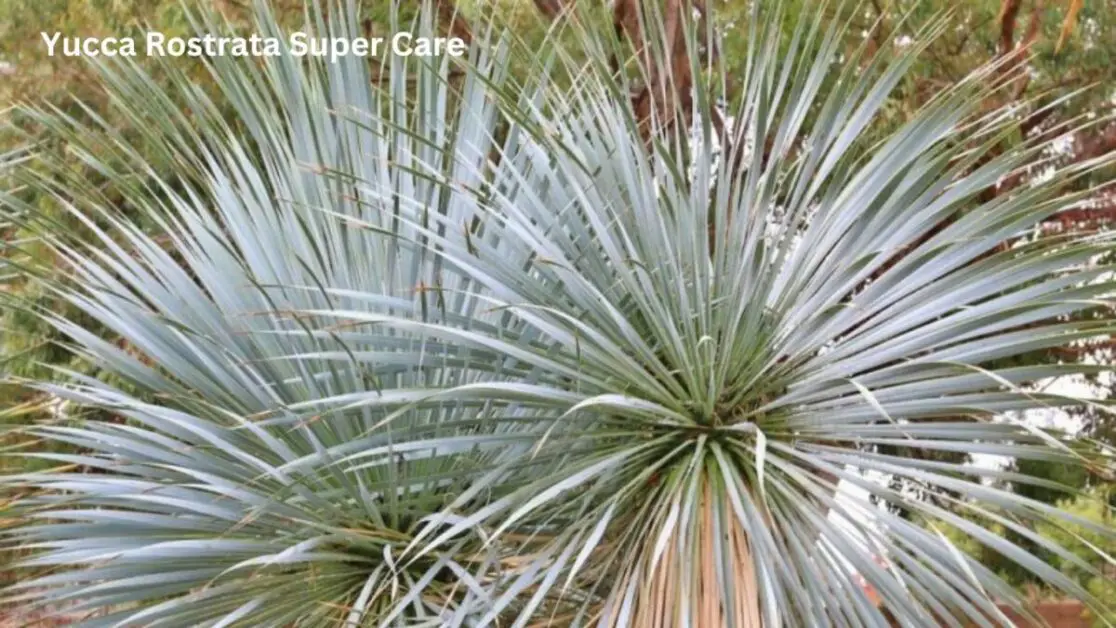
Enhancing the aesthetic appeal of Yucca Rostrata with companion plants is a clever way to create a visually stunning garden or landscape. By strategically selecting and pairing compatible plants, you can transform the appearance of your Yucca Rostrata into a captivating focal point.
When choosing companion plants for Yucca Rostrata, it is important to consider their growth habits, color schemes, and overall compatibility. One popular combination involves planting low-growing succulents or ornamental grasses around the base of the Yucca Rostrata, creating a beautiful contrast in height and texture. Additionally, colorful flowering perennials, such as purple coneflowers or red hot pokers, can add a vibrant burst of color that complements the blue-green foliage of the Yucca Rostrata.
By carefully selecting and pairing companion plants, you can enhance the overall beauty of your Yucca Rostrata, creating a harmonious and visually appealing garden space. However, it is essential to ensure that the companion plants have similar cultural requirements to ensure their healthy growth and well-being. In the next section, we will explore some companion plants that are known to thrive alongside Yucca Rostrata and discuss their ideal growing conditions.
This table provides an overview of key aspects to consider when caring for Yucca Rostrata to ensure optimal growth and health. Adjustments may be necessary based on specific environmental conditions and individual plant needs.
| Aspect of Care | Description |
|---|---|
| Sunlight | Requires full sunlight; ideally positioned in a location with at least 6-8 hours of direct sunlight daily. |
| Watering | Drought tolerant once established; water sparingly, allowing soil to dry out between waterings to prevent root rot. |
| Soil | Well-draining soil is crucial; mix cactus or succulent potting mix with perlite or sand to improve drainage. |
| Temperature | Hardy in USDA zones 5-11; withstands freezing temperatures but may require protection in extreme cold. |
| Fertilization | Minimal fertilization required; feed sparingly with a balanced fertilizer during the growing season (spring to fall). |
| Pruning | Prune dead or damaged leaves as needed; avoid excessive pruning as it may lead to stress and slow growth. |
| Pests | Generally pest resistant; watch for signs of spider mites, scale insects, or mealybugs; treat with insecticidal soap. |
| Diseases | Resistant to most diseases; root rot can occur if overwatered, so ensure proper drainage and avoid waterlogging. |
| Potting/Repotting | Repot young plants annually in spring to refresh soil and provide room for growth; mature plants may not require repotting. |
| Propagation | Propagate from offsets (pups) or seeds; allow offsets to dry before planting in well-draining soil. |
| Winter Care | Protect from excessive moisture during winter months to prevent rot; provide additional mulch or cover in colder climates. |
15. Yucca Rostrata in Containers: Tips
Yucca Rostrata, also known as the Blue Beaked Yucca, can flourish in containers with the right care and attention. Here are some guidelines for effectively cultivating Yucca Rostrata in pots.To begin, selecting a container that offers ample space for the yucca plant to thrive is essential. Opt for a container with a minimum diameter of 18 inches and sufficient depth to accommodate the plant’s lengthy taproot. It is crucial that the container has proper drainage holes to prevent water accumulation, which can lead to root rot.When it comes to soil, a well-draining mixture is vital.
A blend of sand, perlite, and high-quality potting mix in equal parts creates an ideal soil composition. This mix ensures adequate drainage while supplying essential nutrients for the yucca plant’s growth.Regarding watering, finding the right balance is key. Yucca Rostrata is resilient to drought and prefers dry conditions, so it’s important to avoid over-watering.
The frequency of watering should be adjusted based on factors like climate, container size, and soil composition. Allowing the soil to dry out between waterings is crucial to prevent root rot.For fertilizing, applying a balanced slow-release fertilizer during the growing season is recommended. This method provides the necessary nutrients for healthy growth without the risk of excessive fertilization. Follow the instructions on the fertilizer packaging carefully for proper application.
There is one product which I want to recommend using on my personal experience is the Silver Yucca!
The plant, with its smooth, bluish-hued leaves, is a versatile addition to gardens from the desert southwest to the pacific northwest, deep south, and beyond. Thriving in USDA hardiness zones 5-10, this plant can withstand extreme heat and freezing temperatures down to -20F. Its tree-like form, with a beautiful pom-pom-like globe of soft, narrow leaves, adds a unique charm to any setting.The Big Bend Yucca Rostrata is not just a plant; it’s a statement piece that demands attention. With its branching habit and shaggy skirt of leaves, this 3′ ft. 6” beauty is a showstopper in any garden. Its adaptability to various climates and soil types makes it a go-to choice for garden enthusiasts looking for a low-maintenance yet striking addition to their outdoor space.
- Ornamental Beauty: The Big Bend Yucca Rostrata is a visually striking plant with a tree-like appearance and pom-pom-like formation of blue-gray leaves
- Hardiness: Thriving in well-drained, rocky, and sandy soils, this plant is ideal for creating vertical accents in sunny to partially shaded areas
- Low Maintenance: Known for its ease of growth and maintenance, making it suitable for various landscapes, both residential and commercial
- Drought Tolerance: The Big Bend Yucca is extremely drought-tolerant, adapting well to dry conditions and sandy soils
- Soil Drainage: It is essential to plant the Big Bend Yucca in well-drained soil to prevent rot, especially in clay or poorly draining soil
- Leaf Maintenance: While the plant’s leaves form a beautiful skirt around the trunk, occasional grooming may be needed to remove spent flower stalks
Overall, I am delighted with the Silver Yucca product. Its quality surpasses expectations, and its performance has truly impressed me. This product has proven to be a reliable and durable choice, meeting my needs exceptionally well. Its design and functionality have added significant value to my experience, making it a worthwhile investment. I am thoroughly satisfied with the Silver Yucca and would highly recommend it for its outstanding quality.
- High-quality seeds
- Fast shipping
- Limited quantity
- Packaging issues
In conclusion, growing Yucca Rostrata in containers is indeed possible, provided you provide the right conditions. With the proper container size, well-draining soil, careful watering, and appropriate fertilization, you can enjoy the unique beauty of this stunning plant in your container garden.
FAQs
Can Yucca Rostrata be grown in containers?
Yes, Yucca Rostrata can be grown in containers.
What size of container is suitable for Yucca Rostrata?
Yucca Rostrata requires a large container with a depth of at least 18 inches and a diameter of 24 inches.
What type of soil should be used in containers for Yucca Rostrata?
Well-draining soil mixtures, such as a combination of potting soil, sand, and perlite, are ideal for Yucca Rostrata in containers.
How often should Yucca Rostrata be watered when grown in containers?
Yucca Rostrata in containers should be watered thoroughly whenever the top inch of soil feels dry. Avoid overwatering to prevent root rot.
Can Yucca Rostrata in containers be placed indoors?
Yucca Rostrata is best suited for outdoor growth, but it can be temporarily placed indoors as long as it receives sufficient sunlight.
How often should Yucca Rostrata in containers be fertilized?
Yucca Rostrata in containers should be fertilized with a balanced, slow-release fertilizer once every spring.
Can Yucca Rostrata in containers withstand cold temperatures?
Yucca Rostrata in containers can tolerate some cold temperatures, but it is best to bring them indoors or provide protection during freezing conditions.
How can I prevent pests from attacking Yucca Rostrata in containers?
Regularly inspect the plant for pests and treat them with appropriate insecticides or natural remedies. Keep the container clean and free from debris.
Can Yucca Rostrata in containers be propagated?
Yes, Yucca Rostrata can be propagated from stem cuttings or by dividing offsets from the parent plant.
Is it necessary to repot Yucca Rostrata in containers?
Yucca Rostrata may require repotting every few years when the plant outgrows its container. Choose a slightly larger container to accommodate its growth.
Can Yucca Rostrata in containers be placed on a balcony or rooftop?
Yes, Yucca Rostrata in containers can be placed on a balcony or rooftop as long as it receives enough sunlight and is protected from strong winds.


